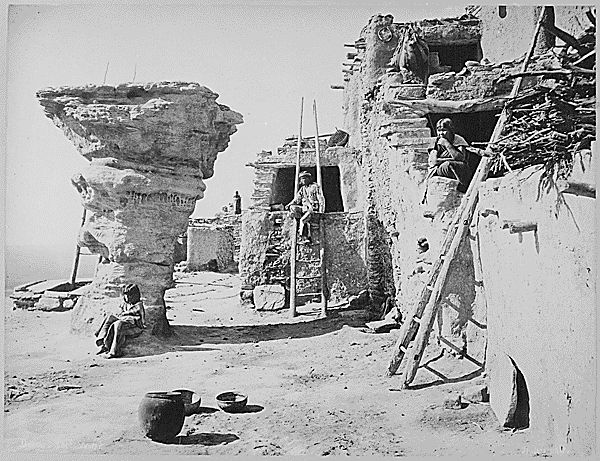
50 Years Ago: Hopi traditionalists sue their tribal council

Traditional Hopis from about 1879. (Photo via Wikipedia.com)
WINDOW ROCK
Back in the 1960s, the battle between the Hopi Tribal Council and traditionalists on the Hopi Reservation raged hot and heavy and Navajo Nation President Raymond Nakai kept in close contact with the traditionalists to win over their support for the Navajos in the Navajo-Hopi Land Dispute.
Nakai pushed the idea that this was a dispute that should be settled by the two tribes and not Congress or the courts. He pointed out that over the last hundred years or so, dozens of Hopis had married Navajos and were raising Navajo-Hopi children so the land dispute didn’t make a lot of sense since it was, in a way, family versus family.
He also pointed out that most of the Navajos who lived on the disputed lands were traditionalists themselves and shared some of the same values as their Hopi “cousins.” In fact, many Hopis turned to Navajo medicine men when they needed a ceremony.
So, in 1965, Nakai watched with interest as the Hopi traditionalists took their tribal council to federal court in an effort to stop any oil exploration on their reservation.
While he didn’t actively oppose the efforts of the Hopi traditionalists, his legal advisers told him that a victory by Hopi traditionalists could spur Navajo anti-oil activists on the Navajo Reservation to file a similar suit against the Navajo government to stop coal mining and oil drilling on the Navajo Reservation, which would cost the tribe tens of millions of dollars.
There was, however, a slight difference between the Hopis and Navajos.
Hopi traditionalists continued to argue that the Hopi Tribal Council was illegal and that the real power on the Hopi Reservation rested in the village governments. For this reason, traditionalists did not participate in anything to do with election of members of the council.
Navajo activists were more active in the tribal government, running for office and pushing within the government to get their voice heard.
On the Hopi side, traditionalists filed suit in November of 1964 in federal court in Phoenix and argued that the Hopi Tribal Council lacked the authority to grant oil leases.
In January of 1965, the suit was dismissed by Federal Judge Walter Bastian, who was a circuit judge out of Washington. He ruled that the federal court had no jurisdiction to hear the case and added that the council’s action was legal.
He also pointed out that the council was recognized by the Bureau of Indian Affairs as having the authority and that the federal authorities had no authority to hear disputes between those who supported the council and those who did not.
Oil exploration had been halted during this period and with the dismissal Kerr-McGee began drilling operations.
This didn’t stop the traditionalist who took their cause to what they believed was a higher source – the president of the United States.
Dan Katchongva, the traditional leader for the Hotevilla village, urged Lyndon Baines Johnson to investigate the activities of the council.
“Mr. President, our peaceful way of life and land are seriously threatened by your government, under the arbitrary rule of the Bureau of Indian Affairs, and the so called Hopi Tribal Council, which does not represent the Hopi people.”
Nothing came of the letter but the war between the council and the traditionalists would wage on and on and on.
Marshall Tome, editor of the Navajo Times, reported this week that the paper’s Dec. 31 edition had struck a nerve among national Indian officials.
The paper ran an article from the Chicago Tribune that outlined dozens of improper actions done by federal officials supposedly on the behalf of the Indian people.
He said that the paper received hundreds of requests for copies and “we could have sold another thousand papers off the reservation.” But while the edition sold out on the reservation, the Times did not have the capability to do another run but Tome said the paper had a few limited copies that were still available.
He also reported in an editorial that he wrote the last week in January that AA meetings were becoming very popular in various communities on the Navajo Reservation as alcohol abuse continued to be a major and growing problem on the reservation.
The movement began, said Tome, back in 1961 when V. W. Werner, who was the education director for the National Council on Alcoholism, visited the reservation and realized that the tribal government was doing nothing to combat the problem, leaving it to the border communities which also wasn’t doing anything to address the problem.
He pushed the tribal government to come up with a sound approach using Alcoholics Anonymous and creating a detox program to help those who needed treatment.
Tome reported that the tribal council had formed a commission, headed by Wilson Halona, to look at the problem and to see what the tribal government could do to encourage young Navajos in school not to drink.
“Today our tribal members are asking these questions: What do our young people think about drinking? How should the subject be incorporated in the school program?”








 Highway 264,
Highway 264, I-40, WB @ Winslow
I-40, WB @ Winslow